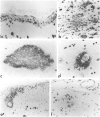A History of Senile Plaques: From Alzheimer to Amyloid Imaging
- PMID: 35595841
- PMCID: PMC9122832
- DOI: 10.1093/jnen/nlac030
A History of Senile Plaques: From Alzheimer to Amyloid Imaging
Abstract
Senile plaques have been studied in postmortem brains for more than 120 years and the resultant knowledge has not only helped us understand the etiology and pathogenesis of Alzheimer disease (AD), but has also pointed to possible modes of prevention and treatment. Within the last 15 years, it has become possible to image plaques in living subjects. This is arguably the single greatest advance in AD research since the identification of the Aβ peptide as the major plaque constituent. The limitations and potentialities of amyloid imaging are still not completely clear but are perhaps best glimpsed through the perspective gained from the accumulated postmortem histological studies. The basic morphological classification of plaques into neuritic, cored and diffuse has been supplemented by sophisticated immunohistochemical and biochemical analyses and increasingly detailed mapping of plaque brain distribution. Changes in plaque classification and staging have in turn contributed to changes in the definition and diagnostic criteria for AD. All of this information continues to be tested by clinicopathological correlations and it is through the insights thereby gained that we will best be able to employ the powerful tool of amyloid imaging.
Keywords: Amyloid; Autopsy; Aβ; Diffuse plaque; Neuritic plaque; Pathology; Positron emission tomography.
© 2022 American Association of Neuropathologists, Inc. All rights reserved.
Figures








References
-
- Khachaturian ZS. A chapter in the development of Alzheimer’s disease research: A case study of public policies on the development and funding of research programs. Alzheimers Dement 2007;3:243–258 - PubMed
-
- Selkoe DJ. Biochemistry and molecular biology of amyloid beta–protein and the mechanism of Alzheimer’s disease. Handb Clin Neurol 2008;89:245–60 - PubMed
-
- Terry RD, Katzman R.. Senile dementia of the Alzheimer type. Ann Neurol 1983;14:497–506 - PubMed
-
- Beach TG. Alzheimer disease and Down syndrome: Scientific symbiosis - a historical commentary. In: Berg JM, Karlinsky H, Holland J, eds. Alzheimer Disease, Down Syndrome and Their Relationship. Oxford: Oxford University Press; 1993:37–52
Publication types
MeSH terms
Substances
Grants and funding
LinkOut - more resources
Full Text Sources
Medical

